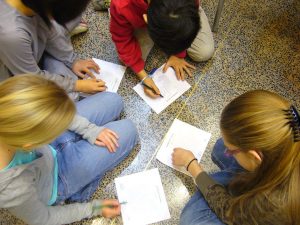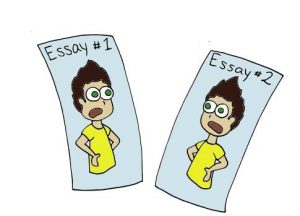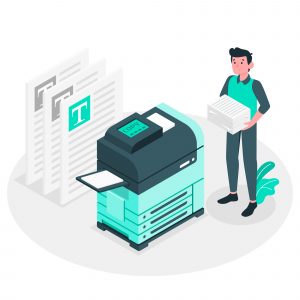5 Other Forms of Plagiarism
Contract Cheating
What is contract cheating?
Contract cheating is a type of plagiarism in which a student submits work created by another person. Contract cheating occurs when someone other than the student completes the assignment and the student submits the assignment as if they completed the work themselves. Contract cheating includes:
- Purchasing papers from online services and submitting them as your own work
- Submitting another person’s paper as your own work, even if you made changes
- Completing assignments for another student which they submit as their own work
Why does contract cheating happen?
There are many reasons why students resort to contract cheating. Common reasons students rely on contract cheating are:
- Lack of time to complete work
- Pressure to achieve high grades
- Lack of motivation to complete the work on their own
- Lack of confidence in academic skills
- Lack of awareness of what is classified as cheating
Regardless of the motivation behind instances of contract cheating, every instance is treated very seriously and is recognized as plagiarism and academic dishonesty.
What are some examples of contract cheating?

In our digital age with websites designed specifically to sell papers and essays to students, contract cheating has become more common. Contract cheating includes instances such as:
- Purchasing a paper or assignment online
- Submitting a paper or an assignment written by another person
- Completing an assignment or paper for another student
- Submitting a take-home exam or test that has been written in full or in part by someone else.
- Buying or otherwise obtaining an unauthorized copy of exam answers or assignments
What are the consequences of contract cheating?
Contract cheating, like all incidents of plagiarism, may have serious consequences. All allegations of contract cheating will be reported to LSUS’s Student Advocacy and Accountability Office. This office will investigate the plagiarism claim and issue the appropriate disciplinary action. Possible disciplinary actions include:
- Receiving a grade of 0 for the assignment
- Receiving a grade of 0 for the course
- Academic suspension
- Academic expulsion
Key Takeaways
- Contract cheating occurs when a student submits work completed by another person.
- Regardless of the reasons why students choose to resort to contract cheating, it is still cheating. Contract cheating is a form of plagiarism, and all instances will be referred to the LSUS Student Advocacy and Accountability Office.
Collusion
What is collusion?
You collude when you submit shared work as individual work. Collusion includes:
- Working on individual assignments, quizzes, or exams with a classmate
- Receiving unauthorized help from a tutor or other person to complete assignments
- Misrepresenting the individual contributions of the group members in group projects
Why is it important to complete individual assignments independently?

Assignments allow professors to assess the knowledge of their students and ensure each student leaves the class having mastered the subject matter. Both contract cheating and collusion defeat the purpose of assignments. When you don’t do your own work, your professors are no longer able to provide a fair evaluation of your efforts. This leaves professors unable to determine whether students have met the learning objectives of their courses. Students who complete their work independently are also better prepared to apply their skills in the workforce after graduation.
Collaboration versus collusion – what is the difference?
Collusion describes situations in which students work together with others on assignments or examinations that are intended to be completed individually. Collusion is a violation of academic integrity and should be avoided.
Collaboration involves students completing assignments as a group when a professor has given explicit permission for students to work together. This is acceptable and does not violate standards of academic integrity.
Mosaic Plagiarism
What is mosaic plagiarism?
Mosaic plagiarism is the use of words, ideas, and structures from one or multiple sources without giving credit to the original sources. This type of plagiarism often occurs when students consult many sources and incorporate their phrasing or structure without providing citations to the original sources. With this type of plagiarism, the student may try to find synonyms for words or change the sentence structure to make the work seem original, but the borrowing of ideas without giving proper credit is still plagiarism.
What are some examples of mosaic plagiarism?
Mosaic plagiarism can take many forms, from cloning the ideas and words of a source exactly to simply “borrowing” the structure of a source. Take a look at some of the examples below to better understand the different types of mosaic plagiarism.
The Clone

The Clone consists of directly copying and pasting someone else’s words without citing the original source. This type of mosaic plagiarism takes the exact wording, phrasing, and appearance of the original source or sources without giving credit. The student inserts no original thought into the cloned work.
| Original | Cloning Plagiarism |
| Beginning as early as the late seventeenth century and continuing throughout the eighteenth century, the Enlightenment swept across Europe. This philosophical movement was characterized by a reliance on human intellectual capabilities. | Beginning as early as the late seventeenth century and continuing throughout the eighteenth century, the Enlightenment swept across Europe. This philosophical movement was characterized by a reliance on human intellectual capabilities |
The Mosaic

The Mosaic involves copying and pasting content from multiple sources and weaving them into one work without giving proper credit to the original sources. This type of mosaic plagiarism involves more thought than The Clone as the student may rephrase some of the words, but ultimately the structure and language remain mostly identical. With The Mosaic, the student may insert some original thought as they intertwine the ‘borrowed’ text to resemble a single, logical work.
| Originals | Mosaic Plagiarism |
| Beginning as early as the late seventeenth century and continuing throughout the eighteenth century, the Enlightenment swept across Europe. This philosophical movement was characterized by a reliance on human intellectual capabilities.
The Age of Enlightenment, or simply the Enlightenment, was an intellectual and philosophical movement that dominated Europe in the 17th and 18th centuries with global influences and effects. The Enlightenment included a range of ideas centered on the value of human happiness… (Wikipedia) |
The Age of Enlightenment, or simply the Enlightenment, was an intellectual and philosophical movement that dominated Europe in the 17th and 18th centuries. This philosophical movement was characterized by a reliance on human intellectual capabilities. This had a great effect on how governments changed during this time. |
The Copy, Paste, and Replace

The Copy, Paste, and Replace consists of copying and pasting from one or multiple sources without proper citation. A few words are then replaced to make it appear as an original work. This type of mosaic plagiarism involves copying and pasting snippets of various sources and weaving those excerpts and incorporating some original thought along with the copied content.
| Original | Copy, Paste, Replace Plagiarism |
| Beginning as early as the late seventeenth century and continuing throughout the eighteenth century, the Enlightenment swept across Europe. This philosophical movement was characterized by a reliance on human intellectual capabilities. | Beginning as early as the 1600s and continuing throughout the 1700s, the Enlightenment spread around Europe. The Enlightenment was characterized by a dependence on human thought. |
The Borrowed Template

The Borrowed Template involves reusing a specific structure that someone else created without acknowledgement. For example, using a template, outline, or form; copying the exact same headings; writing the same number of sentences; and covering the same concepts of a sample report given to you by your instructor all qualify as mosaic plagiarism (unless explicitly allowed by your instructor). This type of mosaic plagiarism involves taking the structure of a work and copying it to fit the assignment content. The Borrowed Template may involve original thought as the student may insert their own specific content into the structure; however, using the exact structure without giving proper credit is still plagiarism.
How can you avoid mosaic plagiarism?
Avoid committing mosaic plagiarism by using the tips below:
- When including exact words, phrases, and ideas that are not your own, be sure to use quotation marks and a proper citation.
- Paraphrase properly! When paraphrasing, be sure to put the words and ideas of the author in your own words. Changing a word or two is not enough. If you are not sure whether the idea is in your own words, use a direct quotation with quotation marks and a proper citation.
- Avoid copying and pasting!
- Use your own words and ideas. Adding quotes from experts is a great way to support your points, but the bulk of your work should be your own ideas. Use quotations and ideas from others sparingly.
Key Takeaways
- Mosaic plagiarism is the use of words, ideas, and structures of one or multiple sources without giving credit to the original sources.
- Mosaic plagiarism can take many forms such as The Clone, The Mosaic, The Copy, Paste, and Replace, and The Borrowed Template
- To avoid mosaic plagiarism, be sure to use your own words and ideas and properly cite your sources.
Self-Plagiarism
What is self-plagiarism?

While plagiarism is the use of another person’s idea or words without permission or proper citation, you can also plagiarize yourself.
Self-plagiarism occurs when a student reuses work that they have already completed or published for another class or assignment. The use of a previously submitted work is misleading to the reader of the work and leaves the impression that the paper or project is original when it is not.
If you are planning to build upon ideas you have previously created and submitted for credit, ask your instructor for permission. Even if you are given permission, remember to cite your previous work!
What are some examples of self-plagiarism?
How do you know if you are committing self-plagiarism? Examples of self-plagiarism include but are not limited to the following:
- Resubmitting an entire paper or project as if it is an original work
- Copy and pasting parts of your previous work into a new work without citing the previous work
- Paraphrasing from your own work without citing the previous work
AI-Assisted Writing
How does AI-assisted writing relate to academic integrity?
While reading this book, you have learned that claiming the work of another person as your own is a violation of academic integrity, but you may be left wondering if the same rules apply when using the work of a non-human entity. The recent emergence of tools such as ChatGPT popularized the use of artificial intelligence (AI) for writing assistance. From outlines to essays to emails, users employ AI writing tools to generate text for various purposes. While these tools are not unethical by nature, it is important to remember that unauthorized use of AI-assisted writing is considered a form of academic misconduct. Unless an instructor specifically mentions the use of AI tools in the instructions for an assignment, it is expected that students will submit their original thoughts rather than text created with AI assistance.
Key Takeaways
- Self-plagiarism happens when you take work that you have previously completed and submit it as an original work.
- Even if you use your own work, you must cite it!
- Some common examples of self-plagiarism are reusing assignments from other classes and turning them in for credit and copy and pasting sections of a previous work into a new work.

